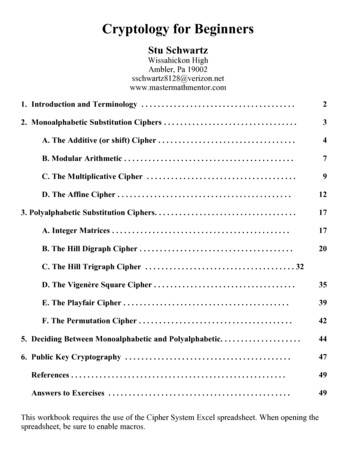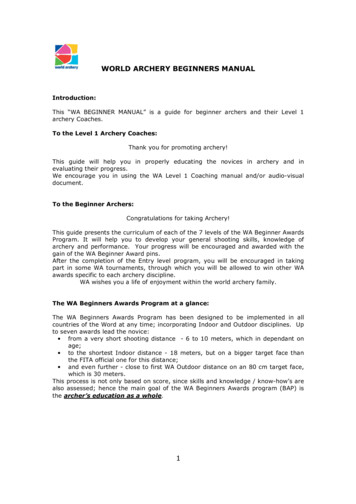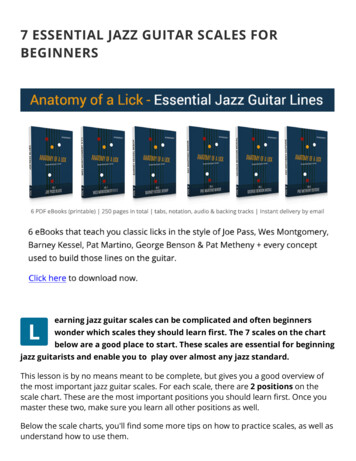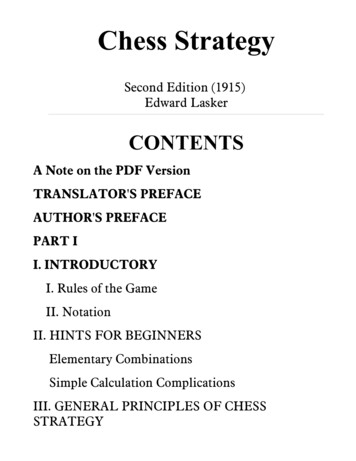
Transcription
Cryptology for BeginnersStu SchwartzWissahickon HighAmbler, Pa .com1. Introduction and Terminology . . . . . . . . . . . . . . . . . . . . . . . . . . . . . . . . . . . . . .22. Monoalphabetic Substitution Ciphers . . . . . . . . . . . . . . . . . . . . . . . . . . . . . . . . .3A. The Additive (or shift) Cipher . . . . . . . . . . . . . . . . . . . . . . . . . . . . . . . . . .4B. Modular Arithmetic . . . . . . . . . . . . . . . . . . . . . . . . . . . . . . . . . . . . . . . . . .7C. The Multiplicative Cipher . . . . . . . . . . . . . . . . . . . . . . . . . . . . . . . . . . . . .9D. The Affine Cipher . . . . . . . . . . . . . . . . . . . . . . . . . . . . . . . . . . . . . . . . . . .123. Polyalphabetic Substitution Ciphers. . . . . . . . . . . . . . . . . . . . . . . . . . . . . . . . . . .17A. Integer Matrices . . . . . . . . . . . . . . . . . . . . . . . . . . . . . . . . . . . . . . . . . . . .17B. The Hill Digraph Cipher . . . . . . . . . . . . . . . . . . . . . . . . . . . . . . . . . . . . . .20C. The Hill Trigraph Cipher . . . . . . . . . . . . . . . . . . . . . . . . . . . . . . . . . . . . . 32D. The Vigenère Square Cipher . . . . . . . . . . . . . . . . . . . . . . . . . . . . . . . . . . .35E. The Playfair Cipher . . . . . . . . . . . . . . . . . . . . . . . . . . . . . . . . . . . . . . . . .39F. The Permutation Cipher . . . . . . . . . . . . . . . . . . . . . . . . . . . . . . . . . . . . . .425. Deciding Between Monoalphabetic and Polyalphabetic. . . . . . . . . . . . . . . . . . . .446. Public Key Cryptography . . . . . . . . . . . . . . . . . . . . . . . . . . . . . . . . . . . . . . . . .47References . . . . . . . . . . . . . . . . . . . . . . . . . . . . . . . . . . . . . . . . . . . . . . . . . . . . .49Answers to Exercises . . . . . . . . . . . . . . . . . . . . . . . . . . . . . . . . . . . . . . . . . . . . .49This workbook requires the use of the Cipher System Excel spreadsheet. When opening thespreadsheet, be sure to enable macros.
Cryptology for BeginnersStu Schwartzsschwartz8128@verizon.net1. Introduction and TerminologyCryptology is defined as the science of making communication incomprehensible to all people exceptthose who have a right to read and understand it. The study of cryptology consists of two parts: cryptography, which concerns itself with the secrecy system itself and its design, and cryptanalysis, which concerns itself with the breaking of the secrecy system above.Most of us associate cryptography with the military, war, and secret agents. And, indeed, those areashave seen extensive use of cryptography. In World War II, for example, a great deal of effort wasexpended to create systems so that the high command could communicate with generals in the field overradio waves with the enemy not being able to decipher it. Even more time was spent in analyzing thesemessages and “breaking the code.”Today we need cryptology because of the everyday use of computers and the Internet. It is important forbusinesses to be able to protect the information in their computers. If you decide to buy a CD fromAmazon.com using your credit card, it is important that no one but Amazon has the ability to read thefile where your credit card number is stored. Electronic fund transfers have made privacy a greatconcern.This booklet will help your understand some simple cryptography systems and teach you how to applysome techniques of cryptanalysis.First, some terminology:Code - a set of information that will allow words to be changed to other words or symbols, For instance,a code for the word “rifle” may be “escargot.” That is not the type of cryptography that lends itself toanalyze. The only way to decode a message is by having the set of words and their codes. If someone isable to get his hands on the codebook, then every secrecy message can be broken. We are interested inmethods of cryptography that lend themselves to explainable techniques that can be performed to changea message into a secret one, and, more importantly, change back by people having the authorization andknowledge to do so.Plaintext - the message that you wish to put into a secret form. Plaintext is usually written in all lowercase letters without spaces. Numbers are written out and punctuation is ignored. So the message“I will meet you at 5 PM in the mall” is written as:iwillmeetyouatfivepminthemallAnother name for plaintext is called “clear.” A message sent “in the clear” is sent without any attemptto alter it.Cipher - the method for altering the plaintextCryptology for Beginners-2-www.mastermathmentor.com - Stu Schwartz
Ciphertext - the secret version of the plaintext. So the plain text:iwillmeetyouatfivepminthemallmay be changed to:NBNQQRJJYDTZFYKNAJURNSYMJRFQQTo make reading the ciphertext easier, the letters are usually written in blocks of 5. The above is:NBNQQ RJJYD TZFYK NAJUR NSYMJ RFQQEncipher - changing from plaintext to ciphertextDecipher - changing from ciphertext to plaintextKey - information that will allow someone to encipher the plaintext and also decipher the ciphertextConverting letters to numbers - as we learn techniques of cryptography, it is necessary to work innumerical form. Computers are used in cryptanalysis and computers work better with numbers thanletters. The simplest method used in converting a letter to a number and vice versa is by using itsposition in the alphabet: a 1, b 2, . z 26. Here is a chart used for conversion. Save it. We willmake extensive use of it.a b c d e f g h i j k l m n o p q r s t u v w x y z1 2 3 4 5 6 7 8 9 10 11 12 13 14 15 16 17 18 19 20 21 22 23 24 25 26A B C D E F G H I J K L M N O P Q R S T U V W X Y ZNote that both lower case and capital letters have the same numerical value. When we have the letter “m”in plaintext, it will be converted to the number 13. When we have the number letter “U”, it will beconverted to the number 21.2. Monoalphabetic Substitution CiphersDon’t let this difficult word upset you. In a monoalphabetic substitution cipher, every character in theplaintext message is replaced with a unique alternative character in the ciphertext message.A type of monoalphabetic substitution cipher is a cryptogram, usually found on the newspaper puzzlepage. You are given a message such asNBNQQ RJJYDT ZFYKN AJURN SYMJR FQQand try to reconstruct the plaintext message. Cryptograms are created using a key (a G, b X, c K,.) People attempt to solve cryptograms by knowing which letters are more likely to occur in Englishphrases and letters which are likely to occur next to each other. We will look at these facts later. But, wewill not examine cryptograms because there is no rule that can be followed that goes from plaintext tociphertext and vice versa. It is like the code book described above. If someone gets the code book, hehas the key.Cryptology for Beginners-3-www.mastermathmentor.com - Stu Schwartz
A. The Additive (or shift) Cipher SystemThe first type of monoalphabetic substitution cipher we wish to examine is called the additive cipher. Inthis cipher method, each plaintext letter is replaced by another character whose position in the alphabetis a certain number of units away. We actually shift each letter a certain number of places over.One of the first additive ciphers was used by Julius Caesar around 50 B.C. Each letter of the alphabetwas replaced by the third letter following it. So, a is replaced by D, b is replaced by E, c is replaced byF, and so on.The problem comes when we get to x. x is the 24th letter of the alphabet. If we add 3 to 24, we get 27.So we go back to the beginning of the alphabet and replace x with A, y with B, and z with c.So once we add, if the number is greater than 26, we subtract 26 from it. The chart shows each letter inplaintext and its corresponding letter in cipher text.plaintextpositionadd 3position ofcipher-textCipher textplaintextpositionadd 3position ofcipher-textCipher w232626x24271y25282z26293QRSTUVWXYZABCSo under an additive cipher with key equal to 3, the message “I would like a pizza” would become:LZRXOGOLNHDSLCCDTo make reading of the ciphertext easier, we will use the convention of putting the letters in blocks offive. There is nothing sacrosanct about the number five. During World War II, the Germans useddifferent numbers of letters in their blocks. The Luftwaffe used four and the German Army used three intheir blocks, for example. So the ciphertext above will be written as:LZRXO GOLNH DSLCC DIt is not necessary to use the number 3 as your additive key. You may choose any number from 1 to 26as your additive key. If, for instance, you choose 22 as your additive key, your chart above wouldchange to the following.Cryptology for Beginners-4-www.mastermathmentor.com - Stu Schwartz
plaintextpositionadd 22position ofcipher-textCipher ositionadd 3position ofcipher-textCipher OPQRSTUVSo under an additive cipher with key equal to 22, the same message “I would like a pizza” wouldbecome ESKQH ZHEGA WJJLE VVW (when the spaces are added for reading ease)Try your own. Encipher the message “The Eagles will win the Super Bowl“ using the additive key of16. Complete the chart first.plaintextpositionadd 16position ofcipher-textCipher nadd 16position ofcipher-textCipher textn14o15p16q17r18s19t20u21v22w23x24y25z26The message is:Although this is a very easy ciphering routine, it still takes time to encipher a message. That is wheretechnology comes in. Open up the Excel spreadsheet called Cipher System. At the bottom, go to thefirst sheet named “additive.”In this and all the ciphering systems on this spreadsheet, you can input a plaintext message and have itenciphered using the corresponding method and key. Since this is an additive cipher routine, you willinput a plaintext message and additive key. Here are the particulars:Cryptology for Beginners-5-www.mastermathmentor.com - Stu Schwartz
Input the plaintext message in cell F2. The message must be in lower case letters and have nospaces. You may have a message of up to 120 characters. More than 120 characters will causethe extra characters to be deleted. Input the additive key in cell C9 (in the box). The number you input should be a number from1 to 26, but in fact may be any whole number at all. If for instance, you use an additive key of30, you are moving the letters 30 positions ahead which is like pushing them only 4 ahead.Try some messages in cell F2 and try changing your additive key. You will see the enciphered messagein red in the middle of the screen.What would happen if your additive key was 26?What other additive keys would give you the same result as adding 26?So enciphering is fairly easy using this spreadsheet. Now. how about deciphering?The easy way of thinking about deciphering a message is simply reversing the process. If we added 3 toencipher, we could simply subtract 3 to decipher. However, you will find that it is much easier torestrict ourselves to addition rather than talk about subtraction. Since adding 26 to the letter positions isthe same as doing nothing, what number could we add to counterbalance the 3 we already added toencipher?So with 3 in your enciphering key cell C9, type 23 in the deciphering key C29. You should go back toyour original message.Suppose you enciphered with 22, what would you decipher with?In general, if a is your enciphering key, your deciphering key is the formulaTry some examples to prove to yourself that this works.Now suppose you were told that the message QUPCV OZGTM BAOMB IXQHH I was encipheredusing an additive cipher system. Could you decipher it?Here’s how: Go to cell O19 and type the cipher message above into that cell. You should be in all capsand have no spaces.Now type different numbers into C29. One of them must work. There are only 26 you have to try. Tryall 26 and prove to yourself that only one gives a message. Your deciphering additive key was .If you wish to now send the message “I’m broke. Can you pay?” to the person who sent it to you, usinghis same encrypting key, what would be the encrypting additive key and what would the message be?Cryptology for Beginners-6-www.mastermathmentor.com - Stu Schwartz
Exercises: Assuming these were created with additive ciphers, find the key andencipher them. You can find these in the ”data” worksheet of theCipher spreadsheet. Highlight the data from the cell (not the cellItself, and then paste in the decoding section of the additive worksheetto save yourself a lot of typing.1.ZNKIG XOCUA RJSUY ZROQK ZUNGB KOYGV UXYIN K2.KVSBM CIUSH HVSOB GKSFH CDFCP ZSABW BSDZS OGSQO ZZAS3.VGFLX GJYWL LGTMQ LZWLA UCWLK LGLZW UGFUW JL4.UFCLR FCBCD CLQCZ JGRXC QUCUG JJRFP MUYQA PCCLN YQQ5.JRCYN AGBIN PNGVB AVAOR EZHQN VAFGR NQBSS YBEVQ NGUVFLRNEB. Modular ArithmeticIn order to communicate in a better fashion, we now have to learn some math terminology. Back ingrade school you learned to use a clock. You were taught that if it is currently 9 A.M. and you want thetime 12 hours from now, you would know that the clock would read the same time. Now these times aredifferent, but the clock wouldn’t know that. So the clock would read the same 12 hours, 24 hours andany multiple of 12 hours in the future or the past, no matter what time it currently is.You were taught this as “clock arithmetic.” If it is 9 o’clock (doesn’t matter whether A.M. or P.M.) andyou want the time 5 hours from now, you would realize that 9 plus 5 14. Since there is no 14 o’clock,you could subtract 12 and get 2 o’clock.If it is 9 o’clock and you are interested in the time 35 hours from now, you could find 9 35 44. Nowcontinually subtract 12 until you get a number between 1 and 12. 44 - 12 32. 32 - 12 20. 20 - 12 8. So it will be 8 o’clock.But suppose it is 9 o’clock and you are interested in the time 1,000 hours from now. Add 9 1,000 andyou get 1,009. You could continually subtract 12, but that would become quite boring and tedious.There is an easier way.Simply divide 12 into 1,009. We are not interested in the quotient. We are interested in the remainder.8412 10091008)Since the remainder is 1, we can say that it will be 1 o’clock 1,000 hours after 9 o’clock.1Cryptology for Beginners-7-www.mastermathmentor.com - Stu Schwartz
To make this easier, we invent a terminology for this process. We called it a modular system.So, when using the clock, we can add 12 or subtract 12 from any number and not change it, we canmake statements like the following:13 ! 1mod12 , 25 ! 1mod12 , 37 ! 1mod12 , !11 " 1mod12 , !23 " 1mod12 .We read the first statement as 13 is congruent (or equal) to 1 in modular system 12. What it also says isthat 12 divides evenly (no remainder) 13 - 1.The second statement 25 ! 1mod12 says that 12 divides evenly into 25 - 1. The statement!11 " 1mod12 says that 12 divides evenly into -11 - 1. (mod is read as “modulo”)When we use a modular system base 12, we wish to express our numbers using the smallest nonnegativenumbers. So we wish to use the numbers 0 to 11 (unlike a clock, 1 to 12).So we say that 12 ! 0 mod12 or 12 divides evenly into 12 - 0.If you wish to change a number mod 12, you divide the number by 12 and look at the remainder. Somecalculators (TI-89) actually have a mod key (located in the 2nd MATH 1: Number 9: mod menu). Tofind 77 mod 12, you would type in mod(77, 12). This can be a pain without a calculator that can takemods, but you can usually make things easier.If you want to find 1234 mod 12, instead of dividing, you can think this way: 12 goes evenly into 1,200so you can say 1234 ! 34 mod12 . Now since 24 2 ! 12 , you can subtract 24 from 34. You get 10. Sowe conclude that 1234 ! 10 mod12 .If you want to find 185 mod 12, you may recall that 122 144. So subtract 144 from 185 and you get41. Since 41 is 5 more than 36 (3 12), you can conclude that 185 ! 5mod12 .You can work in other modulo systems. If I want to find 79 mod 5, you can realize that 75 15 5.Subtract 75 from 79 and you realize that 79 ! 4 mod 5 .If you wish to find 8024 mod 8, you realize that 8 goes evenly into 8,024. So 8024 ! 0 mod 8 .Find the following:129 mod 12444 mod 12403 mod 3219 mod 75,245 mod 4719 mod 15999 mod 92,475 mod 6In the ciphering systems we will use, it is natural to use a mod 26 system. 1 will correspond to A, 2 toB, 3 to C, . Since in a mod 26 system, we use the numbers 0 to 25, there will be no number 26.26 ! 0 mod 26 . So the number 0 will correspond to the letter Z.Cryptology for Beginners-8-www.mastermathmentor.com - Stu Schwartz
Since we do a lot of calculations mod 26, here is a little routine that can make your work simpler if youhave a TI-83 which, unfortunately, does not have a mod key. (the TI-89 does have one)If you wish to find 75 mod 26, use these statements:75 STO X: X - 26 MATH NUM 5:int(X/26) ENTERBy continuing to press 2nd ENTER , you can back up to this statement and simply replace the 75with whatever you wish to find mod 26. You can also change to a different mod by changing thetwo occurrences of the number 26 to whatever you want.So, the additive system adds its key to every letter’s number mod 26. If a plaintext letter is “f” and thekey is 18. We take the position of “f” as 6 and add it to 18. We get 24 which corresponds to the letter“X.”If the plaintext letter is “r” and the key is 19, we add r’s position as 18 and add 19 and get 37. We find37 mod 26 which is 11 which corresponds to “K.”If the plaintext letter is “n” and the key is 12, we add n’s position as 14 and add 12 and get 26. We find26 mod 26 which is 0 which corresponds to “Z.”To reverse the process (decipher), we have to do the opposite process. If the key was 4, we added 4 toevery plaintext position. To decipher, we need to subtract 4. But in modulo systems, we prefer not touse negatives. So realizing that !4 " 22 mod 26 , we add 22 to every letter position mod 26 in theciphertext.We will call the deciphering key the “additive inverse.” The additive inverse of 4 is 22 mod 26.If the key was 19, the decipher key is !19 . But !19 " 7 mod 26 . So we add 7 to every letter positionmod 26 in the ciphertext. So the additive inverse of 19 is 7 mod 26.Find the following additive inverses of the following mod 26:15:1:30:100: 296:Note: it may seem that we are going to a lot of trouble to create a language for a process which seemsfairly easy. Rest assured that there is a good reason to do so and we will spend a great deal of timeworking in mod 26. (Still, don’t try to tell a policeman that if you are caught speeding at 93 mph, youwere really going 15 mph because 93 ! 15mod 26 !)C. The Multiplicative CipherNow that we have tackled modulo systems, the multiplicative system should be easy. Instead of addingthe key to the plaintext letter position, we simply multiply it. So our formula for our ciphertext C isbased on the key k and the plaintext letter P:C kP mod 26Cryptology for Beginners-9-www.mastermathmentor.com - Stu Schwartz
So, if our key is 3, the following table will show how to find the ciphertext:plaintextpositionmultiply by 3mod 26Cipher ositionmultiply by 3mod 26Cipher 780ZSo, using the multiplicative key of 3, how would you encode, “The answer is seventeen.”?Suppose our key was 11. Fill in the chart and encode the very same message. You may find that it iseasier to find your answer mod 26 rather than actually multiply out. I would suggest having a calculatorhandy.plaintextpositionmultiply by11mod 26Cipher nmultiply by11mod 26Cipher textn14o15p16q17r18s19t20u21v22w23x24y25z26Go to your spreadsheet, change to the multiplicative sheet, and type in the plaintext in cell F2. Type thekey in cell B10. Check to see if you are correct.So far, there is no problem. But suppose our multiplicative key was 2? Here is the chart again.Cryptology for Beginners- 10 -www.mastermathmentor.com - Stu Schwartz
plaintextpositionmultiply by 2mod 26Cipher nposition14multiply by 2 28mod 262Cipher scribe the problem created.The message “hi” would be enciphered as “PR.” How would you end up deciphering it?We say that the key 2 is unusable because 2 is not “invertible mod 26.” It turns out that all evennumbers are also unusable because they contain no inverse. What is an inverse anyway?We will define the inverse of a key k, a number k !1 such that k ! k "1 1 mod 26.Think about it: Suppose our key k is 3. We start with the letter “a“ with has a position of 1. Multiply itby 3 and you get 3. Now, to decipher, you want to multiply it by something mod 26 which will get youback to 1. What is that number? .It should be clear now why even numbers have no inverses. We start with the letter a with has a positionof 1. Multiply it by 4 and you get 4. Now, to decipher, you want to multiply it by something mod 26which will get you back to 1. Multiply 4 which is even by any number and you get an even number.Mod 26 it and you still get an even number. So you can never get back to 1.Complete the chart. I give you the key k, and you find the inverse k !1 . It may take you some time.key kinverse k !1135791113151719212325You should have found that one number in the chart also does not have an inverse.No matter how large the multiplicative key is, its inverse, if it has one, will be between 1 and 25.As you use the multiplicative method sheet on the spreadsheet, notice that when you put your key in cellB10, the multiplicative inverse key appears automatically in cell B31. Also note that, if you attempt toput a key in of a number which has no inverse (even numbers or numbers divisible by 13, i.e.,! 13mod 26 ) you will be so informed.So if you put in a message in cell F2, it will be enciphered in red and then deciphered back in greenbelow.Cryptology for Beginners- 11 -www.mastermathmentor.com - Stu Schwartz
Try some examples on your own. Your message must be 120 or fewer characters, typed in lower casewith no spaces. Your multiplicative key must be valid to be able to decipher it.Suppose you were given this message and were told that it was created by a multiplicative cipher:YQDIUSOWJGMGQQQTWPGFUMGQXBGTKYFUUVYou wish to respond but how will you decipher it? Well, knowing that it was created by a multiplicativecipher is quite helpful. In additive ciphers, there were 25 numbers which could have been your additivekey mod 26 (pretty senseless for your key to be zero). With multiplicative keys, there are only 11possibilities (again, senseless for your key to be one). So type this message in cell Q20 and try yourdifferent keys in cell B10.You wish to answer him with “No problem,” using his inverse key as your key. What would yourresponse be?Exercises: The following ciphertexts were created with either additive ormultiplicative ciphers methods. Decipher them and write the methodand key. You can find these in the ”data” worksheet of theCipher spreadsheet. Highlight the data from the cell (not the cellitself, and then paste in the decoding section of the appropriateworksheet to save yourself a lot of typing.1.CIMOG FSXTS SIKDS OYCDD YCVRQ MEFSX TIVOC HNECV XO2.KYVZE KVIEV KJZKV ZJNNN UFKDZ CBJYR BVUFK TFD3.DLANA GIUQN AUDIL COCHD TDCHG QLDKL UHHAR IGJUD DAH4.HESGD ONVDQ FNDRN TSADR TQDSN STQMN EEZKK ZOOKH ZMBDR5.WQHWE QFWQF AQGRY DQLSY XQSGY NUKLV DVGFK VYARY NTKTTD. The Affine CipherIf you were given something written in ciphertext and asked to decipher it, it would be a daunting task.However, if you were told that it was created by an additive cipher, you would know that there are reallyonly 25 possible shifts. If you were told that it was a multiplicative cipher, there are fewer possibilities,only 11. So if you were told that the cipher was created by either an additive or multiplicative cipher,there are only 36 possibilities. With the spreadsheet you have, that is child’s play. 36, the worst casescenario, can be accomplished in minutes.The question is: who would be crazy enough to tell you the actual type of cipher technique used? Itdefeats the problem of deciphering, doesn’t it? This answer question is not as easy as it appearshowever. Later on, I will give good justification for actually telling you the method used to encipher.Cryptology for Beginners- 12 -www.mastermathmentor.com - Stu Schwartz
However, it is clear that the additive and multiplicative methods are to easy to decipher. We will nowexamine the affine cipher method. Affine is a word that means “linear transformation.” The affinemethod is really nothing more than a combination of the multiplicative and additive.In the affine cipher system, we choose a multiplicative number a and and additive number b. If p is aplaintext number, then we define the cipher text number C (ap b) mod 26.For instance, suppose we want to translate the plaintext message “yes” with an affine cipher system witha 5 and b 20. Here are the steps:plaintextposition p5p 20(5p 20) mod 26ciphertexty2514515Oe54519Ss1911511KIf we wanted to translate the plaintext “drink water” with an affine cipher system with a 239 and b 152, here are the steps:plaintextposition p239p 152(239p 152) mod26ciphertextdr4181108 20493218e5134721r1844548ONYGARUHHowever, if we wanted to translate the plaintext “an” with an affine cipher system with a 2 and b 8,here are the steps:plaintextposition p2p 8(2p 8) mod 26ciphertexta11010Jn143610JObviously, we have a problem. There is no problem encoding but the decoding process will beimpossible as the two J’s translate to separate letters (a, and n). Hence some of the a’s and b’s will nothave an inverse. Which are they?Since, the a was the multiplicative number, the rules are the same as they were with the multiplicationcipher system. That is: allowable values of a may not be any even number or congruent to 13 mod 26.So a may be the numbers 1, 3, 5, 7, 9, 11, 15, 17, 19, 21, 23, and 25. There is no restriction on b.As you can see, the number of possibilities in the affine system jumps dramatically. Since there are 12possibilities for a, and 26 possibilities for b, there are 12 26 392 possibilities to try if we wish todecode a message.Go to the spreadsheet, click on the affine method sheet at the bottom, and try to encode some messages.Put a message in F2, a cell B10, and b in cell C10. Note that if a is not a legal number, you will betold so in cell B13, although it will appear that a translation will be accomplished. But it is illegal.Cryptology for Beginners- 13 -www.mastermathmentor.com - Stu Schwartz
So now we come to the decoding process. In order to do so, we need to generate the inverse numbers ofa and b which we will call c and d. This is not so easy. Let’s try an example:Let us suppose that p is the letter we wish to encode. We will use an a of 15 and b of 8. So the ciphertextposition C will be 15p 8 mod 26. From now on, we will use an equal sign instead of ! . To reverse the process, we must solve the equation: Bring the 8 to the other side: Eliminate the negative 8 (add 26) We need to get p by itself. So multiply bothsides by the inverse from the table. (there isno division process). The inverse of 15 is 7 Multiply out Find 126 mod 26 Break the equation into c and dC 15p 8 mod 26 (the encoding equation)C - 8 15p mod 26C 18 15p mod 267(C 18) 1p mod 267C 126 p mod 26p 7c 22 mod 26c 7, d 22In this spreadsheet, c and d are calculated for you in cells B27 and C27.Let’s try another one. p is the letter we wish to encode. We will use an a of 5 and b of 24. So theciphertext position C will be 5p 24 mod 26. To reverse the process, we must solve the equation: Bring the 24 to the other side: Eliminate the negative 24 (add 26) We need to get p by itself. So multiply bothsides by the inverse from the table. (there isno division process). The inverse of 5 is 21 Multiply out Find 42 mod 26 Break the equation into c and dC 5p 24 mod 26 (the encoding equation)C - 24 5p mod 26C 2 5p mod 2621(C 2) p mod 2621C 42 p mod 26p 21c 16 mod 26c 21, d 16This is not easy work. The spreadsheet accomplishes the work easily.Exercises: Try the following by hand. You can certainly use the spreadsheet, butlearning how to decipher requires you to be able to solve these moduloequations. So use the spreadsheet to see if you are correct. It does notmatter what the plaintext message is.1. a 1, b 202. a 9, b 43. a 19, b 24. a 25, b 25Cryptology for Beginners- 14 -www.mastermathmentor.com - Stu Schwartz
5. a 29, b 16. a 101, b 115Now, let’s make things a little more difficult. Suppose you were given this message:RPIID XHIGGG MPOOH UIQVA GONIV QDXYI PQNII AEPRY IIWGOT TThe only thing you know is that it is created by an affine cipher. Where do you begin? You can type itinto cell O19 (making sure an equally long message is in cell F2). Now what?We can start with the fact that there are 392 possibilities for a and b. We can try them all. On theaverage, we will get the solution about the halfway mark or approximately after 200 trials. Assuming ittakes 5 seconds to type your a and b values in and check to
Cryptology for Beginners - 2 - www.mastermathmentor.com - Stu Schwartz Cryptology for Beginners Stu Schwartz sschwartz8128@verizon.net 1. Introduction and Terminology Cryptology is defined as the science of making communication incomprehensible to all people










